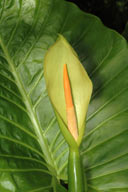In Flower This Week
A weekly news sheet prepared by a Gardens' volunteer.
Numbers before each plant refer to temporary IFTW labels in the gardens.
Numbers in square brackets [ ] refer to garden bed Sections. Plants in flower are in bold type.
View past issues of 'In Flower This Week'.
8 March 2013
Alocasia macrorrhizos click for larger image |
The shrub pictured above, selected to commemorate Canberra’s centenary in 2013, will be seen on this walk as well as many other flowers. The walk starts at the doors of the Visitor Information Centre.
- Rhododendron viriosum, growing in a pot but originally from far north Queensland, displays its attractive orange-red bell-shaped flowers. Swainsona formosa, from the arid areas of our country, is also attractive with large pea-shaped bright red flowers with dark centres.
- Edging Banks Walk Hibbertia vestita [Section 174] has bright yellow open flowers over the dense ground cover.
- In the centre of this bed is a small tree, Corymbia ‘Summer Red’ [Section 174], showy with clusters of red flowers.
- Kangaroo Paws are finishing, however Anigozanthos ‘Bush Pioneer’ [Section 174] still reveals its yellow-green paw flowers on long upright stems.
- Take the road on the far side of the Rainforest Gully where outside the cafe the Swamp Lily, Crinum pedunculatum [Sections 306 and 125], displays its open sprays of white flowers.
- Opposite, the Cunjevoi Lily, Alocasia macrorrhizos [Section 125], with large spade-like fleshy leaves has green or yellow hood-like flowers on long stems.
- Another interesting plant is Clerodendrum floribundum [Section 125], a small tree with button-sized green fruits in enlarged red calyces seen among its rather dense foliage.
- Continuing along this road, Grevillea bipinnatifida ‘Jingle Bells’ [Section 124] is grown as a standard. It has red pendulous flower spikes among the greenery.
- Surrounding it is Grevillea ‘Poorinda Royal Mantle’ [Section 124], a dense groundcover bearing dark red toothbrush-like flowers.
- Around the corner, Scaevola ‘Mauve Clusters’ [Section 124] is also a groundcover with small fan-shaped mauve flowers falling over the rock wall.
- Scaevola albida [Section 124] is similar but its fan-shaped flowers are a pale blue.
- Across the road our grand old Eucalyptus mannifera [Section 10] has lost another of its large mottled white branches.
- Continuing on the road to the left, an emu bush, Eremophila strongylophylla [Section 302], is a low spreading plant with green-grey foliage and prominent purple bugle- shaped flowers.
- At this corner is a group of small open shrubs of Correa ‘Canberra Bells’ [Section 119]. The flowers are bright red and cream.
- Correa alba var. alba [Section 107] is a dense spreading shrub of medium height, with grey-green silver-edged leaves and cream four-petalled flowers.
- Towards the Rock Garden, Epacris longiflora [Section 110] is rather a straggly shrub with tubular flowers coloured red with white mouths hanging in rows from the upright branches.
- A bottlebrush, Callistemon pachyphyllus ‘Smoked Salmon’ [Section 110], bears few pale salmon-coloured flowers on the medium size shrub.
- Close by is Swainsona galegifolia [Section 110] with upright branches bearing mauve-pink pea-shaped flowers
- View the waterfall and ponds where water dragons sleep on the rocks. On the top of the waterfall is a small tree, Geissois biagiana [Section 15q], so prominent with its crown of bright red new leaves.
- At the exit to this area, between the flower pots, is another emu bush, Eremophila bignoniiflora × polyclada [Section 15r]. It is a low open shrub with remarkably large pale mauve bugle-shaped flowers.
So many plants to view in this area!
Barbara Daly
![Director of National Parks [logo]](../../../../images/dnp_90px.gif)







